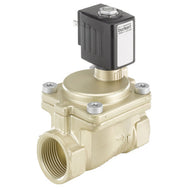Collection:Brass Solenoid Valves
Brass solenoid valves are prized for their robustness, versatility, and excellent corrosion resistance. These valves combine the durability and reliability of brass with the precision and quick ... Read more
Brass Solenoid Valves

Brass solenoid valves are prized for their robustness, versatility, and excellent corrosion resistance. These valves combine the durability and reliability of brass with the precision and quick response of solenoid operation. Brass, an alloy of copper and zinc, offers a balance of properties that make it an ideal material for valve construction, including good thermal conductivity, ease of machining, and resistance to wear and tear. This makes brass 2-way solenoid valves a preferred choice for a wide range of applications where cost-effectiveness and performance are key considerations.
Common applications for brass solenoid valves
- Water treatment systems
- Irrigation and sprinkler systems
- Heating and cooling systems
- Pneumatic systems
- Automotive systems
- Fuel and gas dispensing
- Medical and dental equipment
- Industrial machinery
- Food and beverage processing
- Chemical dosing systems
- Laundry and dry-cleaning equipment
- Boiler and steam control
Selecting the right brass 2-way solenoid valve
When selecting a brass 2-way solenoid valve, it is important to consider the following criteria to ensure the valve meets the specific needs of your application:
-
Material: When selecting brass solenoid valves, bronze is often presented as an alternative option.
- Brass: Brass solenoid valves are ideal for typical water systems, air control with minimal moisture, low-pressure steam, automotive fluid management, and applications requiring complex valve shapes due to their ease of machining.
- Bronze: Bronze solenoid valves excel in marine environments with saltwater exposure, industrial settings with corrosive chemicals or acids, high-temperature steam applications, and drinking water systems that require lead-free materials.
- Connection size: The connection size of the valve must match the piping in the system. It is crucial to select the correct size, which is often measured in inches or millimeters, to ensure a leak-free installation and proper flow rates.
-
Connection type: The type of connection will determine how the valve is attached to the system.
- Flanged: Flanged connections are suitable for larger pipes or higher pressures.
- Threaded: Threaded connections, including NPT (National Pipe Thread), BSPP (British Standard Pipe Parallel), and metric, are common for smaller pipes and are easy to install.
- Push-on: Push-on connections offer a tool-free installation, making them convenient for quick maintenance or replacement.
- Function: The function of the valve determines its default state. Normally open valves allow flow when de-energized, while normally closed valves block flow when de-energized. Bistable valves maintain their last position regardless of power state. The choice depends on the desired control scheme and safety considerations.
- Voltage: The voltage required to operate the solenoid must be compatible with the available power supply. The correct voltage and type (AC or DC) are essential for proper valve operation.
- Seal material: The seal material must be compatible with the media being controlled to prevent leaks and ensure longevity. Common seal materials include NBR (nitrile rubber), EPDM (ethylene propylene diene monomer), and Viton (fluoroelastomer), each with different chemical resistance properties.
- Operation: The operation type of the valve should be chosen based on the pressure differential in the system. Direct-acting valves are suitable for low-pressure applications, indirect-acting valves require a pressure differential, and semi-direct valves can operate in a range of pressure conditions.
- Recommended media: The media that the valve will control should be considered to ensure compatibility with the brass construction and seal materials. Brass valves are commonly used for water, air, and oil, among other media.
- Approval: Depending on the application, certain approvals may be necessary for compliance with industry standards or safety regulations. These can include certifications for drinking water compatibility, gas systems, explosive atmospheres (ATEX), and electrical safety (UL).
- Kv value: The Kv value is a measure of the flow rate through a valve at a given pressure drop. It is important to select a valve with an appropriate Kv value to ensure that the system can deliver the required flow rate.



